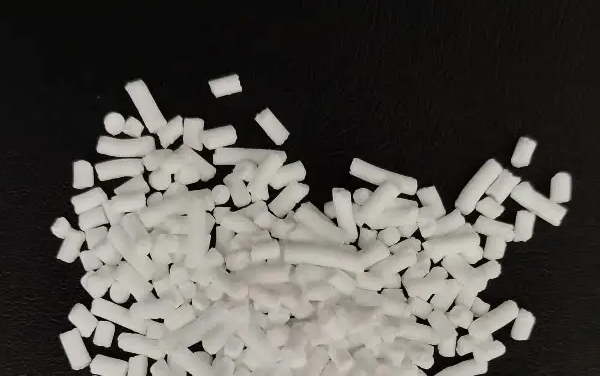
1. Curing agent

It can cross-link with resin in the process of powder melting to form an insoluble and infusible three-way network structure, which is relatively stable and has certain mechanical properties. The curing agent plays a decisive role in the aggregation state of the high polymer, and plays a crucial role in the film-forming conditions during the storage period of the powder.
1. Epoxy curing agent
Thermosetting powder coating curing agent, epoxy curing agent is the most complex, mainly divided into three categories of amines, acid anhydrides and phenols.
1.1 Dicyandiamide
Dicyandiamide: white crystal, melting point 207-207℃, activated and reacted with epoxy resin above 150℃. The addition amount is 3%-4% of the resin.
advantage:
It is not easy to yellow the coating film, and it is cheap and easy to obtain.
shortcoming:
High melting point and poor epoxy resin miscibility, low reactivity, 200 ℃ melting for 30 minutes.
Improve:
1. Micronization
2. Add curing accelerator, oxazole, quaternary ammonium salt to form accelerated dicyandiamide
3. Introduce groups with good compatibility with resin to form substituted dicyandiamide
1.22 Diacid dihydrazide
White crystalline powder, melting point 185-190℃. It has a certain compatibility with the resin, and the addition amount is 7-8% of the resin.
advantage:
Coating film flexibility, water resistance, corrosion resistance, good insulation, high coating density, no pinholes
shortcoming:
High curing concentration and relatively strict operating conditions
Improve:
Combined with imidazole accelerators, it has been widely used in anti-corrosion pipeline applications
1.3 Imidazole and its derivatives
Imidazole is a heterocyclic compound, white crystal, boiling point is 260-280℃, activation temperature is 82-87℃, the addition amount is 0.3-0.5% of the resin.
Mainly include: 2-sulfylimidazole, 2-ethylimidazole, 2-phenylimidazoline
advantage:
Low curing temperature, good thermal stability, less dosage, good film performance
shortcoming:
The powder has a short shelf life and is easy to agglomerate
Improve:
1. Combine imidazole with acetic acid, lactic acid, and phosphoric acid to form imidazole salts
2. Form coordination compounds with imidazole and copper-nickel, cobalt and other metal salts
Function: prolong the storage period of the powder, the addition amount of imidazole salt is 0.6-1% of the resin, and it can also be used as a curing accelerator.
21 Triglycidyl isocyanurate
White crystalline powder, melting point 90-110℃, epoxy value 90-110. Good compatibility with resin, polyepoxy triazine heterocyclic compound, the dosage is 7-8% of resin.
advantage:
1. The number of epoxy groups is large, the activity is high, the cross-linking density is large, and the triazine heterocycle is the parent body, which is heat-resistant, flame-resistant and has high hardness.
2. It does not contain benzene ring and ether, and has good UV resistance, gloss retention and color retention.
2.2 Hydroxyalkylamide (HAA)
Compounds containing hydroxyalkylamide groups are excellent curing agents for weather-resistant polyesters in powder coatings. Compared with the TGIC curing agent widely used at home and abroad, it has the characteristics of low toxicity, non-irritating skin and fast curing speed.
The coatings have outstanding outdoor performance and are truly green and environmentally friendly high-quality products.
application
1. Due to the low activation energy of HAA, the traditional carboxyl polyester for TGIC cannot be used, but a special polyester for HAA should be selected.
Such as DSM's P855P865, Cytec's CC7630CC7618CCE37498, Hangzhou Sino-French 9337-
T105, 3099 of Zhejiang Tiansong, etc.
2. For polyesters with an acid value of 30~35mgKOH/g. The amount of F125 is 5% of the amount of polyester. The amount of F125B is 6% of the amount of polyester.
3. The manufacturing and processing methods of powders of HAA system and other systems are basically the same, but in order to enhance the dispersibility of HAA, the extrusion temperature needs to be slightly higher, about 115-120 °C.
4. The curing conditions are: 180℃/15min or 190℃/10~12min
Comparison of two curing agents:
The typical variety of HAA is tetrakis (N-B hydroxyethyl) adipamide (BHEDA). The melting point of HAA is above 120 ℃. has its own characteristics
(1) The equivalent weight of -HEDA is 82-86g/eq, which is slightly lower than that of TGIC. Therefore, in the formulation of powder coatings by mass, the curing speed is faster and the dosage can be less.
(2) Since its dosage is lower than that of TGIC, the plasticizing effect on the powder is lower, and the Tq of the obtained powder coating is higher than that of TGIC.
Therefore, the powder has good storage stability, chemical stability, alkali resistance, and hydrolysis resistance.
(3) The ammonia-containing structure of B-HEDA does not require the addition of ammonia-containing compound additives. It has inherent frictional charging properties and is suitable for friction spray gun construction.
(4) The toxicity of B-HEDA is relatively low, the genetic teratogenicity and carcinogenicity tests are negative, and the acute toxicity and irritation to the skin and eyes are very low.
The disadvantage of the polyester/HAA system powder coating is that there are small molecules released during the curing and crosslinking process, so it cannot be applied thickly, otherwise it is easy to cause pinholes and other diseases, and the heat resistance is worse than that of the polyester/TGIC system. The high-gloss flat powder coating formulated with hydroxyalkylamide will affect its decorative properties because the surface is not dense enough after film formation.